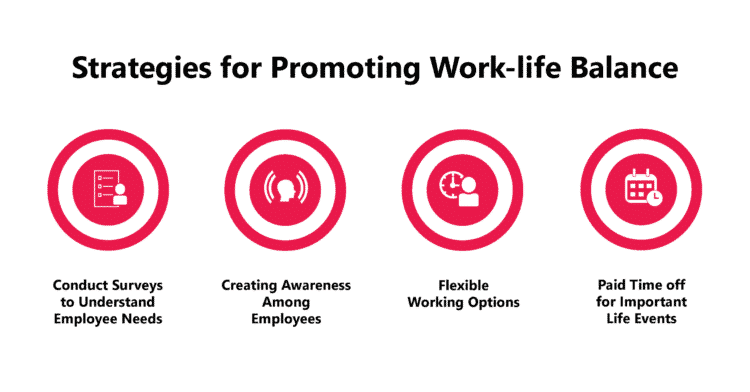1. Promoting work-life balance enhances employee engagement, motivation, and overall well-being, leading to higher productivity.
2. Organizations can achieve this by conducting surveys to understand employee needs, creating awareness about the importance of work-life balance, and offering flexible working options.
3. Providing paid time off for significant life events further reinforces employees’ sense of belonging and loyalty to the organization.
4. These strategies help employees maintain a healthy balance between their professional responsibilities and personal lives.
Most employees today work in highly stressful and competitive environments, where the traditional 9-5 work schedule has become rare. This schedule impacts their personal and professional lives, so organizations today try to promote a better work-life balance for their employees.

The concept of work-life balance is a key part of almost every corporate discussion these days.
HR experts consider it critical for building a highly motivated and engaged workforce. It is the ability to achieve a sense of balance between personal and professional lives.
A healthy work-life balance allows employees to excel at work while enjoying a fulfilling life outside of it.
Employees can split their time evenly to fulfill their professional responsibilities and passions.

A healthy balance between work and life positively impacts employee engagement and motivation, promoting good health and overall happiness.
A poor work-life balance, on the other hand, leaves employees in poor physical, mental, and emotional health reducing their productivity.
For example, employees who let their work eat into their time tend to remain constantly stressed.

As a result, employees become accustomed to working long hours, with little to no time for relaxation or pursuing other interests.
They become mentally and emotionally burdened, face the risk of burnout at work, and fall out in personal relationships.
The corporate world has numerous examples of organizations losing their top talent to this vicious cycle.

Most employers struggle to ensure sufficient personal time, despite the importance of maintaining a healthy balance between work and personal life.
However, organizations can consider implementing the following strategies to help their employees achieve this objective:
1. Conduct surveys to understand employee needs
2. Create awareness among employees
3. Provide flexible working options
4. Offer paid time off for significant life events


Ensuring a healthy balance between work and employees’ lives is almost impossible without organizations first trying to understand their employees’ needs.
Hence, organizations should conduct surveys to gain a better understanding of various work-life balance-related factors.
Excessive work pressure, unrealistic project deadlines, and the burden of personal responsibilities are common reasons for stress.
Hence, identifying these issues helps organizations develop strategies to ensure a better balance between work and life, leading to higher employee motivation.

Often, employees fail to understand the importance of maintaining a healthy balance between work and personal life.
Hence, in such cases, organizations need to create awareness about this important subject and the benefits of the same.
Therefore, organizing seminars, professional presentations, or interaction sessions with experts from the field can prove highly effective.
In addition to providing proper guidance, these awareness programs equip individuals with the right tools for a balanced and healthy life.

Allowing employees flexible working options is one of the most effective ways to ensure a better balance between work and personal needs.
Flexi-working enables employees to plan their professional tasks so that they have ample time to fulfill their personal responsibilities.
For example, employees with school-going children might be allowed to start work early to help manage their time more effectively.
Similarly, those with very young children or aged parents who require attention can work from home.
In numerous similar situations, providing flexible work options can be a boon for the employees.

Some personal events in employees’ lives are so significant that they take priority over work.
Events such as engagement, marriage, parenthood, or even an immediate family member’s death fall under this category.
Offering paid time off to employees to attend such life events can help enhance the sense of belonging and loyalty to the organization.
It significantly impacts employee motivation, resulting in higher productivity and a greater business impact.
The efforts made by employers to ensure a healthy work-life balance assure employees of being valued not just as an asset but also as a human being. It can help in increasing the overall productivity and efficiency of the workforce.

Lead author: Sagar Chaudhuri, the Co-Founder and CEO of HiFives. He is an HR Tech Evangelist with over 25 years of experience in both corporate and entrepreneurial settings. Previously, Sagar has held leadership roles with companies such as Genpact, Infosys, and ICICI Bank. He has an engineering degree from IIT Kharagpur and an MBA from IIM Lucknow. Connect on LinkedIn
To stay updated on the latest HiFives blogs, follow us on Twitter (@MyHiFives)